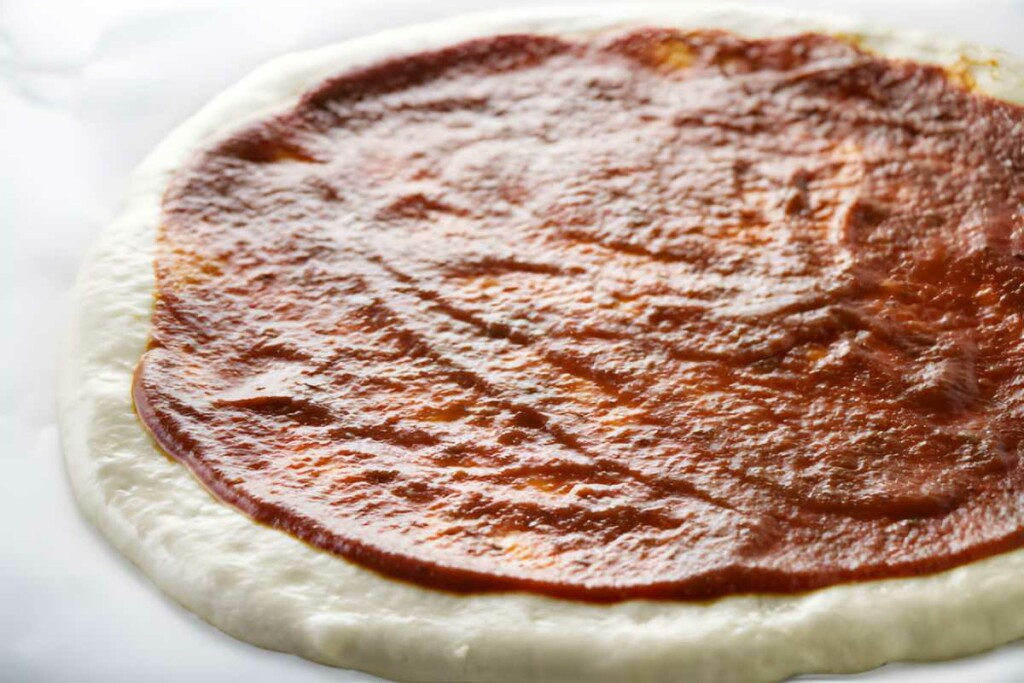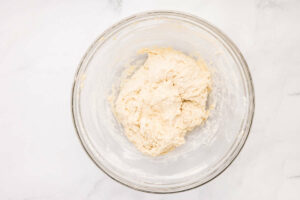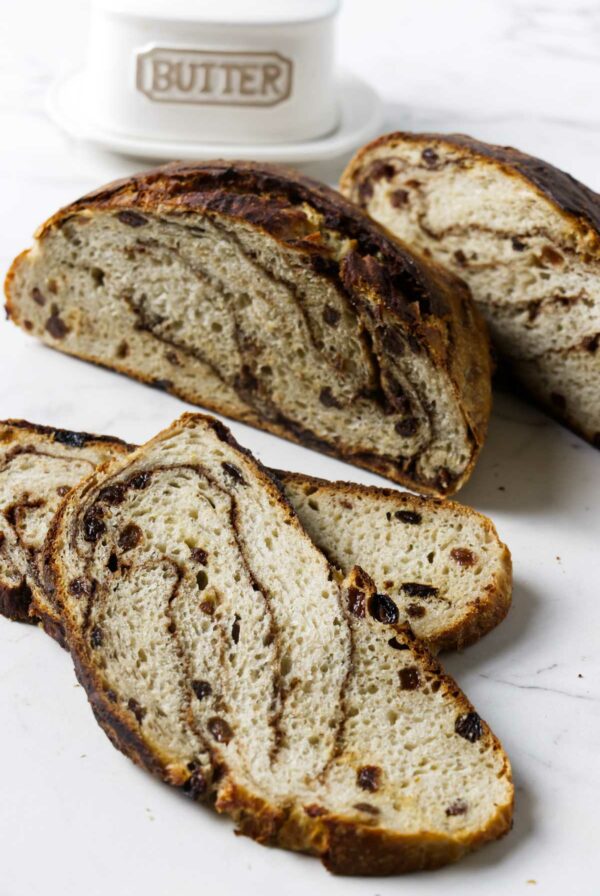This post may contain affiliate links. Please read our disclosure policy. As an Amazon Associate, I earn from qualifying purchases.
Quick pizza dough doesn’t have to mean bland or boring. This one comes together fast, holds its shape like a champ, and bakes up with that proper chewy texture and crisp edges you actually want.
No gimmicks, no mystery ingredients, just dependable dough that’s easy to work with and freezer-friendly, too. Roll it out on a whim or stash a few portions in the freezer for later. Either way, this crust delivers without the wait.

Here is Why This Quick Pizza Dough Recipe Works
Fast rise, real results: Thanks to Quick-Rise yeast (or RapidRise yeast), the dough is ready to shape in about 15 minutes, not 90.
Freezer-friendly: Make a batch, freeze some, and future-you will be glad you did.
Use whatever flour you’ve got: Bread, all-purpose, or pizza flour all work, each one brings a slightly different texture, but you’ll get a great crust either way.
Legit pizza texture: Chewy, crisp-edged, and sturdy enough to hold toppings without turning into a floppy mess.

What kind of flour should I use for this pizza dough?
It depends on what kind of crust you’re after, but the good news is, most common flours work just fine. Here’s a quick breakdown:
All-purpose flour: Gives you a slightly chewy crust with more crispiness. Great if you want something classic and easy.
Bread flour: Higher protein = more gluten = more chew. It creates a slightly puffier, more elastic crust.
’00’ pizza flour: Super finely milled with high gluten content, but it behaves differently than bread flour. You’ll get that crisp-meets-chewy texture, and the dough is easy to stretch.
No need to overthink it, use what you’ve got. The dough is forgiving, and each flour brings something a little different to the table.

Recipe Tips
Use warm water: Aim for around 110°F to speed up the activity of the yeast and get a fast rise.
Use a kitchen scale if you’ve got one: Measuring by weight is far more accurate, especially with flour, which can vary a lot by volume.
Start with less flour: It’s easier to fix sticky dough than to rescue a dry brick. Add more only as needed.
Oil your hands: Sticky dough clings to dry hands. A little olive oil makes shaping way easier (and adds a bit of flavor, too).
Warm it up: Cold kitchens slow everything down. Let the dough rise somewhere warm to speed things up and improve texture.
Let the dough rest: Even a 10-minute bench rest helps the gluten relax, so the dough stretches without snapping back.
Skip the rolling pin for bubbly crust: Use your hands to stretch the dough if you want those nice air pockets
Use parchment : Keeps the crust from sticking and makes clean up easier.
Pro tip: If you’re using a baking steel or stone, let it preheat for at least 30 minutes for the best bottom crust.
Don’t overload the toppings: Too much sauce or cheese = soggy crust and sad pizza night.

Answers to Common Dough Dilemmas
Baking homemade pizza is straightforward, but a few small tweaks can help you get that golden, bubbly finish:
Shape the dough into 10–12″ rounds and place on parchment or press into a greased sheet pan
If you’re using a pizza peel and stone, dust the peel with cornmeal and shape the dough right on top
Add pizza sauce and toppings of choice. (My White Garlic Sauce for Pizza is also a good choice.
Bake at 450°F for 12 to 15 minutes, or until the crust is golden and the cheese is melted and bubbly
This dough works with just about any pizza. Here are some ideas:
– Mushroom pizza with garlic sauce
– Chicken spinach pizza
– Chicken-mushroom pizza
– Mexican chicken pizza
– Buffalo chicken pizza
– Sausage and onion pizza
Storing Leftovers
- Refrigerate: Extra dough can hang out in the fridge for up to 3 days. Lightly coat it in oil and seal in a container or zip-top bag.
- Freeze: Wrap each dough ball in plastic, then stash in a freezer bag with the air pressed out. Freeze for up to 3 months.
- To thaw: Thaw dough in the fridge overnight, then let it rest at room temp for 20–30 minutes before shaping.

For more pizza dough recipes, try my sourdough pizza dough and my whole grain Einkorn pizza crust. I also have an Ooni pizza dough with a lower hydration.
Reliable Homemade Pizza Dough
Quick pizza dough that’s fast, reliable, and actually tastes like real pizza? This one delivers. It’s flexible enough to handle weeknights or freezer prep, and the short rise time doesn’t mean you’re sacrificing texture. Crisp edges, chewy center, no special flour or drama required. Once you see how easy it is, store-bought dough won’t stand a chance.
Pin this now to find it later!
Pin It
Fast Pizza Dough
If you make this recipe, please leave a star rating and comment.
Ingredients
- 4 to 4½ cups all-purpose flour, pizza flour, or bread flour (480 to 540 grams)
- 1 tablespoon granulated sugar, (13 grams)
- 2 teaspoons salt, (12 grams)
- 2¼ teaspoons Quick Rise Instant yeast, (7 grams or 1 packet)
- 1½ cups water, warm; (354 grams)
- 3 tablespoons olive oil, (39 grams)
Instructions
- Preheat the oven to 450°F if you plan to bake a pizza (otherwise you can freeze the dough after you make it).
- Combine 4 cups of flour, sugar, salt, and yeast in a mixing bowl and whisk together.

- Add the water and olive oil. Mix until blended. If it is too wet, gradually add enough flour to make a soft dough. The dough should be slightly sticky.

- Transfer the dough to a floured surface and knead until smooth, about 5 minutes (you can also use your stand mixer with a dough hook).

- Place the dough in a greased bowl and let it rest on the counter for 10 to 15 minutes if you use Quick Rise instant or for 60 to 90 minutes if you use standard instant yeast. The dough should almost double in size.

- Divide the dough into two balls.

- At this point, you can either freeze the dough or prep it for a pizza.
To freeze the dough:
- Coat each ball of dough in some olive oil. Wrap the dough in plastic wrap then slide it into a zipper-seal bag.
- Squeeze all the air out of the bag then freeze if for up to 3 months.
To Bake the pizza:
- Roll the balls of dough into 10 to 12” circles and place them on a sheet of parchment paper (or press them into a greased sheet pan). Form a rim around the pizza dough by rolling the edges in and pinching.

- Spread pizza sauce on the dough and add your desired toppings.

- Bake for 12 to 15 minutes until the edges are golden brown and the cheese is bubbly (a thicker crust will need to bake for 20 to 22 minutes).
Notes
Nutrition
Nutrition information is automatically calculated, so should only be used as an approximation.
 Like this recipe? Rate & comment below!
Like this recipe? Rate & comment below!The Process Photos

















perfect pizza! thank you!! delicious!
I’m glad you enjoyed it. Thanks for the comment.
delicious crust! I’ve never made a pizza crust that turned out! I made mine 12 inches around. 10 minutes in the oven. The crust was baked perfectly !
That’s awesome! I’m so glad it turned out perfectly for you. Thanks for sharing.
When I double the recipe the ingredients change but the amount of flour stays at 4 cups, I’m just curious if that should be all 8 cups for 2x recipe?
Thanks for pointing that out! I tested the scaling feature in different browsers and all the ingredients (including the flour amount) update correctly when doubled. Perhaps you have a browser settings or extensions that are conflicting with the recipe card. You might try doing a hard refresh. Otherwise the doubled amount for the flour is 8 to 9 cups flour (960 to 1,080 grams).
Have you tried making personal pizzas with this recipe? How many pizzas did it make, and how did you adjust the bake time?
Yes, you can definitely make personal pizzas with this dough! If you divide it into 4 balls, you’ll get pizzas about 6–8 inches across and if you divide it into 6 balls, the pizzas will be around 5–6 inches each. For either option, the bake time will be around 7–10 minutes. Just watch for golden edges and bubbly cheese to know they’re ready.